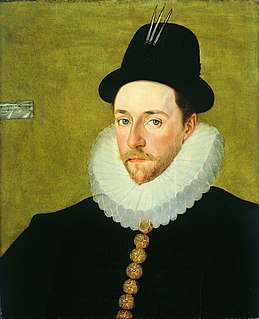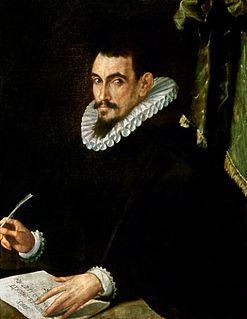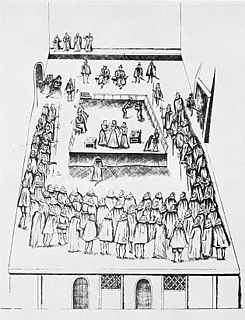
Edward de Vere, 17th Earl of Oxford was an English peer and courtier of the Elizabethan era. Oxford was heir to the second oldest earldom in the kingdom, a court favourite for a time, a sought-after patron of the arts, and noted by his contemporaries as a lyric poet and court playwright, but his volatile temperament precluded him from attaining any courtly or governmental responsibility and contributed to the dissipation of his estate.

Sir Philip Sidney was an English poet, courtier, scholar and soldier who is remembered as one of the most prominent figures of the Elizabethan age. His works include Astrophel and Stella, The Defence of Poesy and The Countess of Pembroke's Arcadia.
Stephen Gosson was an English satirist.

John Rainolds was an English academic and churchman, of Puritan views. He is remembered for his role in the Authorized Version of the Bible, a project of which he was initiator.

Penelope Rich, Lady Rich, later styled Penelope Blount was an English court office holder. She served as lady-in-waiting to the English queen Anne of Denmark. She was the sister of Robert Devereux, 2nd Earl of Essex, and is traditionally thought to be the inspiration for "Stella" of Sir Philip Sidney's Astrophel and Stella sonnet sequence. She married Robert Rich, 3rd Baron Rich and had a public liaison with Charles Blount, Baron Mountjoy, whom she married in an unlicensed ceremony following her divorce from Rich. She died in 1607.

John Casimir, Count Palatine of Simmern was a German prince and a younger son of Frederick III, Elector Palatine. A firm Calvinist, he was a leader of mercenary troops in the religious wars of the time, including the Dutch Revolt. From 1583–1592 he acted as regent for his nephew, Elector Palatine Frederick IV.

Elizabethan literature refers to bodies of work produced during the reign of Queen Elizabeth I (1558–1603), and is one of the most splendid ages of English literature. In addition to drama and the theatre, it saw a flowering of poetry, with new forms like the sonnet, the Spenserian stanza, and dramatic blank verse, as well as prose, including historical chronicles, pamphlets, and the first English novels. Major writers include William Shakespeare, Edmund Spenser, Christopher Marlowe, Richard Hooker, Ben Jonson, Philip Sidney and Thomas Kyd.

Peregrine Bertie, 13th Baron Willoughby de Eresby was the son of Catherine Willoughby, 12th Baroness Willoughby de Eresby, and Richard Bertie. Bertie was Lady Willoughby de Eresby's second husband, the first being Charles Brandon, Duke of Suffolk. Peregrine Bertie's half-brothers, Henry and Charles Brandon, died as teenagers four years before his birth. His sister Susan married the Earl of Kent and then the nephew of Bess of Hardwick. Owing to religious politics, the parents had to move outside England and the boy was born at Wesel on the River Rhine.

Frances Burke, Countess of Clanricarde and Dowager Countess of Essex was an English noblewoman. The daughter of Sir Francis Walsingham, Elizabeth I's Secretary of State, she became the wife of Sir Philip Sidney at age 16. Her second husband was Queen Elizabeth's favourite, Robert Devereaux Earl of Essex, with whom she had five children. Two years after his execution in 1601, she married Richard Burke, Earl of Clanricarde, and went to live with him in Ireland.
Benedict Barnham was a London merchant, alderman and sheriff of London and MP.
Thomas Watson (1555–1592) was an English poet and translator, and the pioneer of the English madrigal. His lyrics aside, he wrote largely in Latin, also being the first to translate Sophocles's Antigone from Greek. His incorporation of Italianate forms into English lyric verse influenced a generation of English writers, including Shakespeare, who was referred to in 1595 by William Covell as "Watson's heyre" (heir). He wrote both English and Latin compositions, and was particularly admired for the Latin. His unusual 18-line sonnets were influential, although the form was not generally taken up.
Richard Al(l)ison was an English composer. He wrote de la Tromba, a fine broken consort piece which has several professional recordings and first became well known due to the Julian Bream Consort.

John Harington, 1st Baron Harington of Exton in Rutland, was an English courtier and politician.

Thomas Stapleton was an English Catholic controversialist.

Giacomo Castelvetro was an Italian expatriate in Europe and England, humanist, teacher and travel writer.

Robert Beale was an English diplomat, administrator, and antiquary in the reign of Elizabeth I. As Clerk of the Privy Council, Beale wrote the official record of the execution of Mary, Queen of Scots, to which he was an eyewitness.
Sir William Herbert was a Welsh colonist in Ireland, author and Member of Parliament.
Sir Thomas Wilkes was an English civil servant and diplomat during the reign of Elizabeth I of England. He served as Clerk of the Privy Council, Member of Parliament for Downton and Southampton, and English member of the Council of State of the Netherlands, and on many diplomatic missions for the English government.
Lodowick Bryskett, was a poet, translator, diplomat and Irish official. He served as Special Ambassador from England to Tuscany in 1600-1.
Sir Edward Stradling (1529–1609) was an English politician, antiquary and literary patron.












